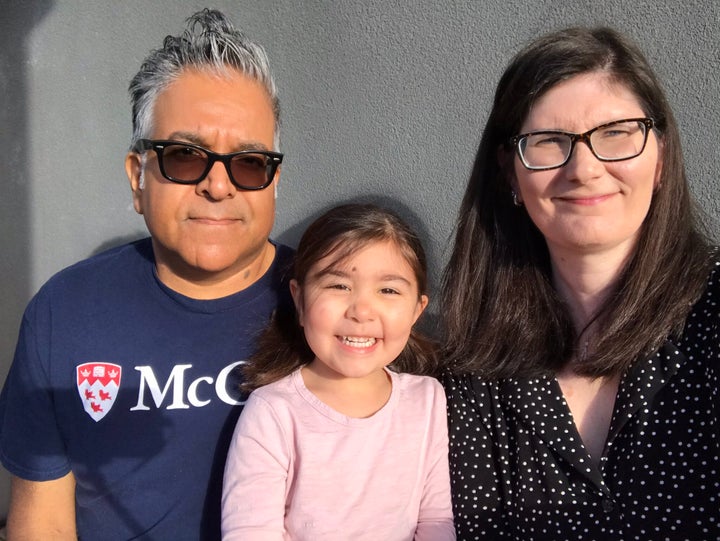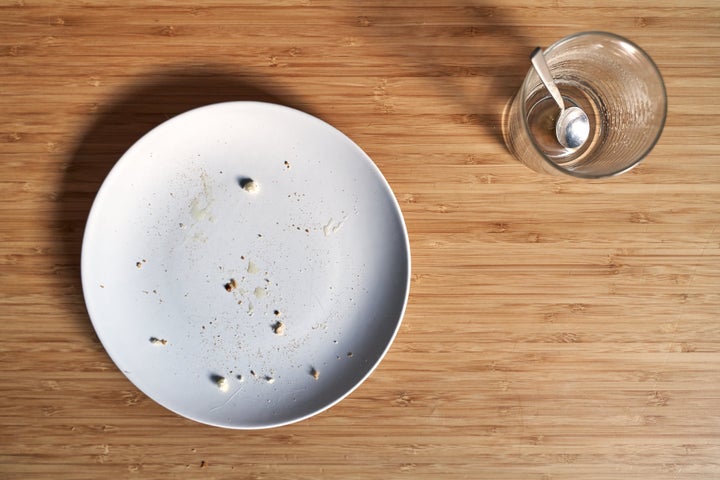
This is the first in an ongoing HuffPost Canada series on food insecurity and how it’s affecting Canadians during the COVID-19 pandemic. In this edition, we talk to an Ottawa-based household of three about their problems accessing healthy meals and the hard health choices they’ve made while living paycheque-to-paycheque.
In a lot of ways, the Cole-Sadiqs don’t fit the picture of what hungry Canadians look like.
Anne Cole is a social-service sector worker who makes around $50,000 a year. Her family rents a condo in Ottawa and she drives a good car. The 42-year-old would describe her family as looking “put-together.” But under the surface, their household is one in eight across the country that faces food insecurity. The front-line worker struggles every month to put meals on the table.
Her husband, Kareem Sadiq, 48, is a stay-at-home dad for their four-year-old, Zoë. He’s been unemployed since 2018, when he quit a government job after experiences he’s described as racial discrimination; Sadiq has written about this on Twitter and says he’s owed back-pay.
Before the pandemic hit, the family was adjusting to a major lifestyle change. With Sadiq’s six-figure salary gone, the vacations and dine-outs with friends they were used to became unaffordable.

Over the last year, the couple made sure to save money wherever they could: buying used toys for Zoë’s Christmas gifts, accepting small family loans and donations to get by. They had high hopes that things would improve once Zoë was in subsidized daycare, which would give Sadiq, who doesn’t qualify for the Canada Emergency Response Benefit (CERB), a chance to job hunt.
The health crisis, they said, magnified their lack of prospects, which in turn has limited their options for affordable, healthy food.
It’s not a good place to be, especially when trying to stay healthy during a pandemic. A Canadian Medical Association Journal study published in January revealed that Canadian households facing food insecurity were also at higher risk of increased mortality rates. Other studies have shown that food-insecure people are vulnerable to developing health conditions like diabetes and poor mental health.
“We’ve literally changed our lifestyle to be conscious of being food poor,” she told HuffPost Canada. “It isn’t easy to go from living what I consider an upper-middle-class kind of life to really being on the edge every day.”
‘We can’t afford to eat healthy anymore’
What they spend on food in a week: $110 (around $36 per person)
What they ate recently: Eggs, toast, hot dogs, salad and veggie chili. The adults skipped lunch.
Cole: “One of the first things that had to leave our diet was eating meat on a regular basis. Now, I shop and get the cheapest thing. Instead of having a lovely steak, it’s something you have to marinate for two days or it’s going to break your teeth.
I used to be really careful with what I ate. I was very conscious of how many calories I put in my body. I can’t really do that because I have to eat more pasta and bread to not be hungry [on the job]. Instead of eating beautiful vegetables and low-calorie options, now we eat more packaged food.”
Sadiq: “I thought I had my blood sugar under control. I used to use artificial sweetener with my tea. Well, let’s just use sugar because it’s cheaper. Last month, I was diagnosed with Type 2 diabetes. I’ve had all sorts of weird health problems. I think moving from the sweetener to the sugar, small things like that, pushed me over the edge.”
Watch: 4 meals you can make for less than $10. Story continues after video
Grocery shopping is a safety concern
Cole: “One of the big things I do is be really thoughtful about planning for a whole week. I really do the math ahead of time, thinking about how to get enough nutrients to balance a day. I buy a lot of frozen vegetables, but during the beginning of the COVID-19 crisis, that went flying off the shelves.
At first, we weren’t sure how we were going to access food. The lineups at Food Basics are longer than the ones at Canadian Superstore. The other thing, lower-cost grocery stores aren’t as careful with social distancing and cleanliness. For a short period of time, I bit the bullet and shopped at Loblaws because it felt safer. But I noticed it was costing more money, so I had to stop.
I shop every sale, I check all the flyers. I’m super careful and I give myself a budget. We can’t afford to eat healthy anymore. I spend more time at the grocery store than I used to because I have to read every single price and try to get the healthiest thing for the lowest cost. People get really annoyed with me because they can’t go by me. I try to hug my cart and go by a wall.”
The irony of being a hungry front-line worker
In her front-line supervisor role, Cole helps people with disabilities access affordable, healthy meals. But at home, she’s pulling out all the stops to keep her family from going hungry.
Cole: “When I put [the food] into packages to go out to people, I think ‘I would love to have that for dinner.’ They’re nutritional, low in sugar, all these things I don’t have access to. It’s ironic. Here I’m doing this for people, but I can’t do it for myself. But I’m happy the individuals I support can access it and I’m thrilled they have that opportunity.”

The family is hoping the promised pandemic wage increase of $4 per hour for front-line workers will make a measurable difference. It was supposed to show up on Cole’s last paycheque, but an unexplained delay has kept it away. Whenever it does land, Cole notes that the 16-week duration isn’t long enough and her sector was already devalued pre-pandemic by Ontario Premier Doug Ford’s government cuts. (Some of these cuts have been scrapped following public backlash.)
Stigma of food bank use
The Cole-Sadiq family have used their local food bank once in the last several months and have not gone since the pandemic began, but they are considering returning. During their last visit, they managed to spread four days of food over a few weeks. (The couple was told that households are limited to one visit per month at the time.)
Cole: “I’ve actually taken people to the food bank as a support worker in the past. Now I’m taking myself and my family. I was petrified that individuals I support would show up at the food bank at the same time. Here I am, telling people it’s OK to go to the food bank, but then telling myself it’s not OK. That was a really hard challenge.”
Sadiq: “There’s a racial element to food insecurity. The sheer number of people of colour relative to white people, it’s jarring … There’s a lot of working poor people. People are coming there on their lunch breaks, getting their food and hightailing it like a bat out of hell to get back to work.”
Interviews have been condensed for clarity.